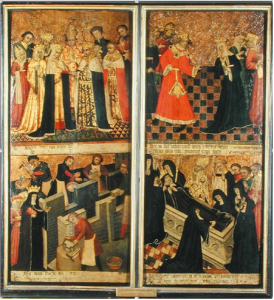Tuesday June 23rd
Tuesday 23rd June sees the commemoration of one of my favourite saints (primarily because I’m concentrating on her cult at the moment within my research). She is St Æthelthryth of Ely, also known variously as Etheldreda, Audrée, and Audrey. She was born in 636 in Exning in Cambridgeshire, the daughter of an Anglian king, and was married firstly to an Anglo-Saxon prince (who died not long after the marriage) and subsequently to a Northumbrian king, Ecgfrith. The marriage was one of political convenience between the Anglian and Northumbrian dynasties and throughout it, and this is where I have some sympathy with Ecgfrith, Æthelthryth resolved to remain a virgin despite the king’s repeated attempts to persuade her otherwise. At one stage, he is reported as chasing her through the Fens in an attempt to bring her back to his court, and he was only thwarted by Æthelthryth’s miraculous ability to make the waters of the Fens rise and to survive by producing drinking water from bare rock.
After Ecgfrith finally gave up his futile quest to fulfil his conjugal rights, Æthelthryth was allowed to enter the convent at Coldingham, and a year later became the founding abbess at Ely, where she stayed until her death in 679. She was succeeded there by her sister, Seaxburh, who was responsible for translating Æthelthryth’s relics into a new coffin sixteen years later, whereupon it was found that her remains were amazingly uncorrupted, and a tumour on her neck that was probably the cause of her death had miraculously disappeared, leaving only a healed scar in its place.
The images on the panel above reflect Æthelthryth’s story up to this point, portraying her marriage to Ecgfrith, her entry into the convent at Coldingham, the foundation of the abbey at Ely and her translation in 695. However, it is only after this point that we get to see the real influence she wielded, with her cult enduring (with varying degrees of success) right through until the Reformation. As well as seeing the beneficial Æthelthryth – curing the sick and relieving the afflicted, as all good saints should do – we also see her vengeful and retributive side, with accounts of a Viking’s eyes being torn from his head for desecrating her tomb and severe punishments for anyone who threatened the security of Ely or its community. With the abbey at Ely experiencing the Danish invasions in the ninth century, Benedictine reform in the tenth, and siege and subsequent submission to the Normans in the twelfth, Æthelthryth was kept quite busy protecting her foundation from all-comers, and judging by the punishments she meted out, you didn’t mess with her without very good reason. So as it’s her saint’s day this week, it might well pay you to be nice to Æthelthryth, you never know what she might do if you’re not!

